Journey to the Top of the Freedom Tower
![]()
In March of 2013, I found myself back at Carnegie Mellon University in Pittsburgh. I had been invited there by Illah Nourbakhsh and a couple of their Directors to assist in teaching a group of educators about our EPIC Pro, as well as the benefits of what high-res imaging offered to classrooms.
After that, we both returned back to our homes and jobs, but not before we committed to discussing further collaboration. I took the opportunity to send him one of our devices and forward some of the gigapixel images I took while back at CMU.

I’d say it was at this point that he really began to consider the possibilities. Because it wasn’t more than a week later that I received an email that said “And now I have an idea! Let’s chat. This could be epic.” The next day we were on a conference call. Plans for the One World Trade Center Panorama had begun.
Prep Work from 3,000 Miles Away
Over the next couple of months, Jonathan tenaciously forged ahead with getting access to the building, while our team at Gigapan worked on a way to help bring the vision in Jonathan’s head to life.
It was a vision inspired by Joe McNally’s photo from the top of the Empire State Building, the one that showed a man changing the beacon bulb. This meant that our initial idea of mounting 4 EPIC Pro set ups to the handrails at the top of the Spire was a no go because it left out the beacon – a key element that Jonathan wanted to have included in the image. That left us with one option: get the EPIC Pro and the camera off the platform and elevated. This proved to be no small feat.
As the days and weeks passed, Gigapan mechanical engineer, Michael Long worked tirelessly though several concepts we had thrown around. I won’t bore you with the details, but it took a face-to-face meeting with the Port Authority NY NJ and the construction foreman in July before we could agree on a final design that met all of their safety requirements. But once we had our design, it was full steam ahead with production.
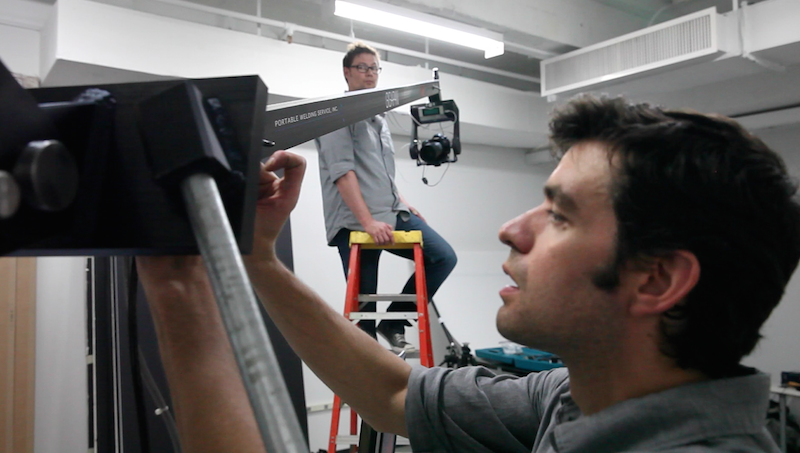
The final jib design was manufactured by Portable Welding Services, Inc. out of North Carolina, who had two of these jibs delivered 10 days after we sent in the order. One was for the actual shoot and went to NY, and the second arrived at the Gigapan offices in Portland, OR for testing.
We had our jib, now we just had to learn how to use it. This isn’t as easy as you might think. Most panoramic photo setups are fairly simple: normally, you can just set the EPIC Pro on a tripod, follow the intuitive menu prompts and press go. The EPIC Pro does all the work for you.
This image was NOT going to be this easy. It required remote control of the EPIC Pro, control of the camera’s exposure settings and focus, and live view. So we developed our own custom software called Capture Studio, and set about testing… and testing… and testing. Hundreds of hours spent testing, because once we got up there we would have one shot to get this right, and you DON’T want to be the company that lost the cover of TIME magazine because you weren’t prepared.
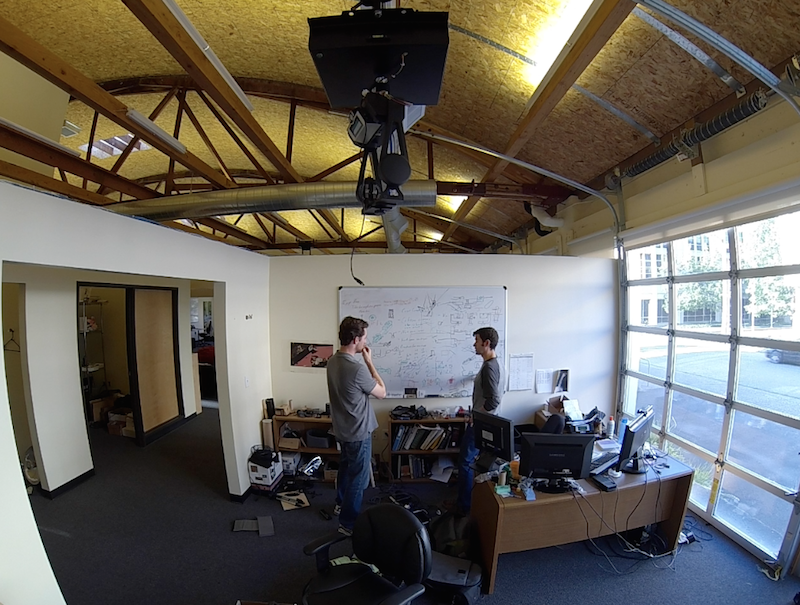
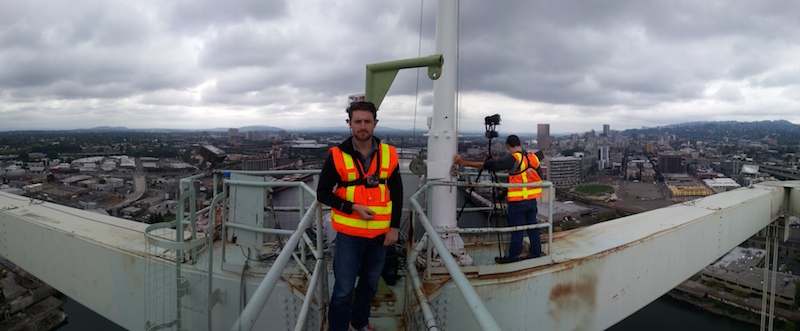
We tested indoors and out, from our warehouse to the top of the Portland Fremont Bridge (with permission of course), where all we got was 800 low-res JPEGs thanks to a fun software glitch that we were thrilled to discover in OR and not after shooting on top of the 1WTC.
Day after day we tested, patiently waiting for favorable weather conditions in New York and making sure we were ready when Mother Nature decided to oblige. In late September, our window of opportunity finally presented itself, and Michael Long and I packed up all our gear and headed out to NY for 5 invaluable and dare I say life-changing days.
I’ll never forget our approach on the evening of September 25th: I was in a window seat as we approached Manhattan at dusk. I remember looking down at this magnificent city, focusing on all the buildings reaching towards the sky, when we flew over 1WTC. It was as if I could have reached out and touched the tip as we flew over. This building just dwarfed everything around it. It was at this moment that I truly grasped that magnitude of what I was about to be a part of.
Prep Work from 1,756ft (.33 miles) Straight Up
September 26th, 2013
Jonathan Woods, Michael Long, Nathan Weber, Phil Weber and I all meet at Jonathan’s office to set to work. Today is a big day. We’re meeting with the Port Authority NY NJ and the ironworkers that would be escorting us up to the top to show them the jib and go over safety stuff.
This is also the first time that we will have access to the top of the building. Not to the top of the Spire, but the top of the communications rings atop the building. Still, we’re about to (legally) stand atop the Freedom Tower… we’re pretty amped.
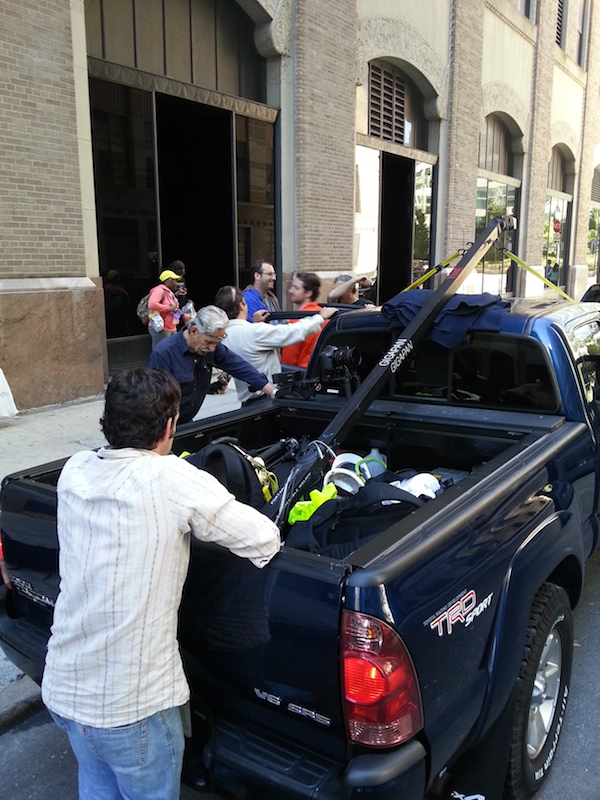
So we load the jib out of the building through the freight elevators and into the back of Jonathan’s truck (not as small a task as you would expect) and head out through Midtown Manhattan to the Lincoln Highway and down to the site of One World Trade Center.
Words can’t express the things that are going through my mind as we drive south, watching that building grow as we draw closer to the building. The thrill has started setting in.
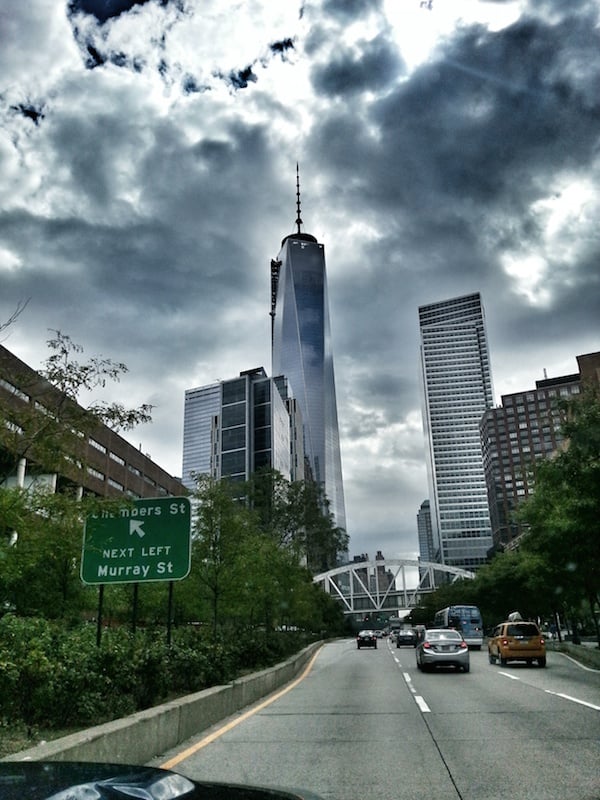
Once there, we unload the jib and make our way to the construction entrance where we meet with the Port Authority and the ironworkers, exchanged 30 minutes of introductions and a safety briefing, put on hard hats and vests, and head to the construction elevator for our 7-minute ride to the top. As the metal cage opens up, we step out to what I can only describe as “amazing” — and this is just an introduction to what we will experience in the next 30 minutes, and a fraction of what Jonathan and I will get to see in two days time.
Nothing could have prepared us for the view from those rings that day. Manhattan, one of the most iconic skylines in the world, seems to go on forever and the sounds of everyday life simply fade away. After scouting the location and taking a bunch of personal photos and selfies (you know you’d do the same) we head back down to the bottom and run through the final schedule with our escorts, the ironworkers, for the official shoot in two days. Day one: check. PIC’s

September 27th, 2013
We’re a complete go for shoot day, but there are still plenty of things to be done. For starters, we made some minor modifications to the jib we tested with back in Portland, OR. These same modifications needed to be made on the jib in NY.
For the next several hours we focus everything we have on ensuring our success. As Jonathan said in the ‘Making Of’ video, “This was a one and done deal.” We aren’t going to have another opportunity to shoot this. It needs to be done right the first time. We have to try and account for all potential issues and plan accordingly.
![]()
We all work non-stop to make sure that everything we need or may need is in the two packs we are taking with us to the top, or at the communication rings for quick access. By about 6pm we have finished up and are confident we’re ready for the next day.
Jonathan, Michael, Nathan and I all head out for a bite to eat, and then bed. We want to make sure that we’re well rested for tomorrow… as if. Being rested sounds great in theory, but when you are less than 24-hours away from the biggest photo shoot of your life, you tend to have a difficult time calming your mind. Finally, after hours of tossing and turning, my brain shuts down and I manage to rest. Day two: check.
September 28th, 2013 (Aka. Go Time)
At 5am, Jonathan, Michael and I are rudely awakened by the alarm on my phone. It’s a good thing I need it for selfies at the top or I would chuck it against the wall. The mustering of bodies begins. I shut the alarm off and immediately check my email, as if something more important might have come in… yeah right.
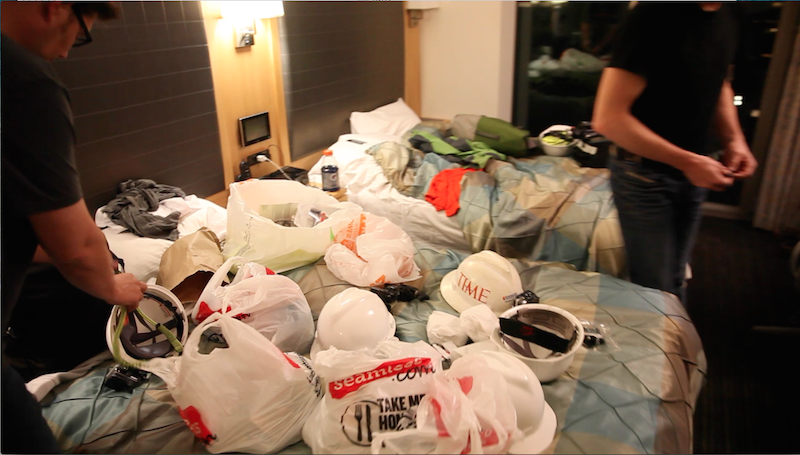
We all begin moving and within 30 minutes our hotel room contains 5 people and 10 bags filled with hard hats, safety vest, lanyards, a slew of snacks and some breakfast. I’ve learned enough in my years to know that what goes in eventually has to come out… no breakfast for me, thanks.
It’s all a little surreal: the day has finally arrived. After six months of planning and preparation, we are a go. Jonathan, Michael and I carefully re-check each of the backpacks that are heading to the top with us, while Nathan starts filming “B roll.” Can’t afford to make any mistakes today.
As the clock ticks away, we pack everything up and head to the lobby to grab the jib, lay it in the truck and head to the site.
Two hours have never gone by so fast! As we arrive on site, we are greeted by foreman Kevin P. Murphy and the three veteran ironworkers that will be escorting us to the top of the spire. Entering the construction trailer, we sign our waivers that release liability and get suited up with our harnesses. Finally, with everyone signed and suited up with the proper safety gear, we exit the trailer and head back to the elevator. It’s now time to make history.
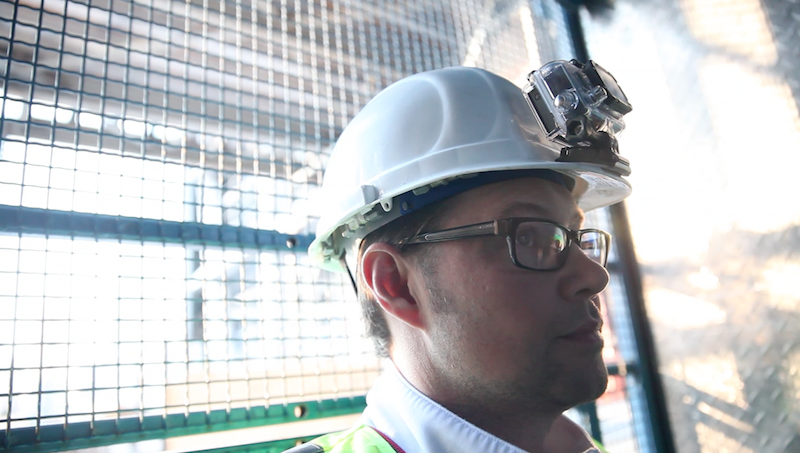
The 7-minute ride to the top seems like an eternity, the pressure mounting with each passing moment. Finally, we reach the top and the steel grate door opens to clear blue skies. The clear blue skies that we have been praying for. It was the only day in the 10-day forecast that gave us any hope of clear skies, and it had arrived in glorious fashion.
With all the gear ready to go at the base of the spire, we gather together for a brief discussion so I can explain what needs to happen when we get to the top. After we go through things, the ironworkers begin their ascent.
We let two of them get a head start because they are hauling our gear up by hand. That’s right, no nifty elevator to get things to the top. Everything we have, those men have to haul by rope, hand over hand, platform by platform, until it’s at the top. God bless them.
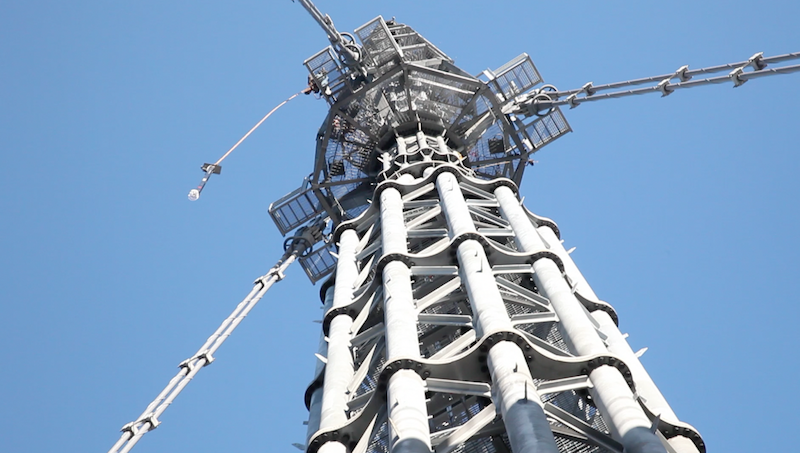
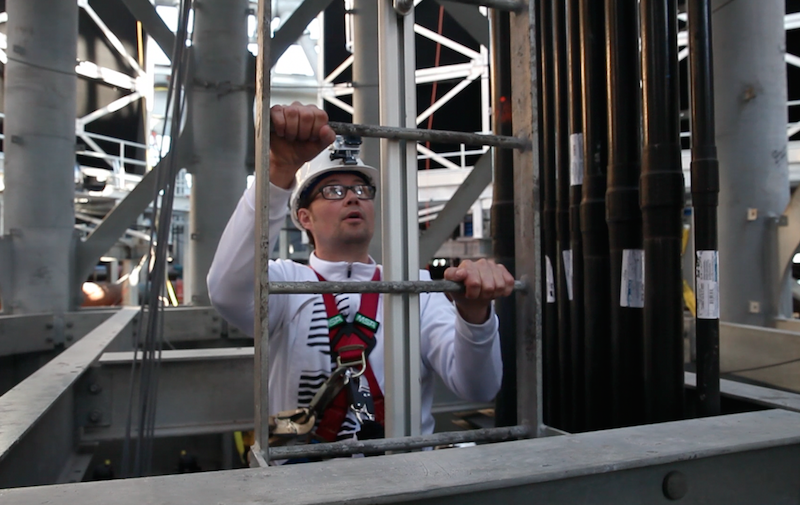
Once the ironworkers are far enough ahead, Jonathan and I start our own ascent: 405 feet, hand over hand, rung by rung. It takes 45 minutes, but finally I make it to the top and take in the most breathtaking view I have ever seen!
Sadly, now is not the time to enjoy the view. Five grown men on a 10-foot wide platform with two 50 pound backpacks and 13 feet of aluminum beam does not leave a lot of room for moving around. It’s a bit like playing Twister at 1,756 feet, which sounds more fun than it is. Once we’re all in what seems to be a logical position on the platform, we set to work.
Setup goes something like this (feel free to skip past this part if you’re not the nerdy type):
1) First thing we need to do is get the Master Control Unit (MCU) put into place. That’s our fancy name for a shaped piece of plywood with a power strip, CPU and router attached.
The CPU contains the Capture Studio software that allows us to control the EPIC Pro, see what the camera is seeing and adjust settings like focus, ISO, aperture, white balance and shutter speed. It also gives us the ability to see the images in correlation to where there are on the grid – an important function since the final image is going to be made up of 567 individual images and we only have one shot at getting them all right.
We shot the whole thing with a Canon 5D Mark III and a 100mm f/2.8L lens. Most of the image you see is shot at infinite focus. The beacon being only about 10 feet away, however, was out of focus on the first pass. By using Capture Studio, I was able to select the individual frames of the bacon and spire and make sure that the focus was sharp on each of them.
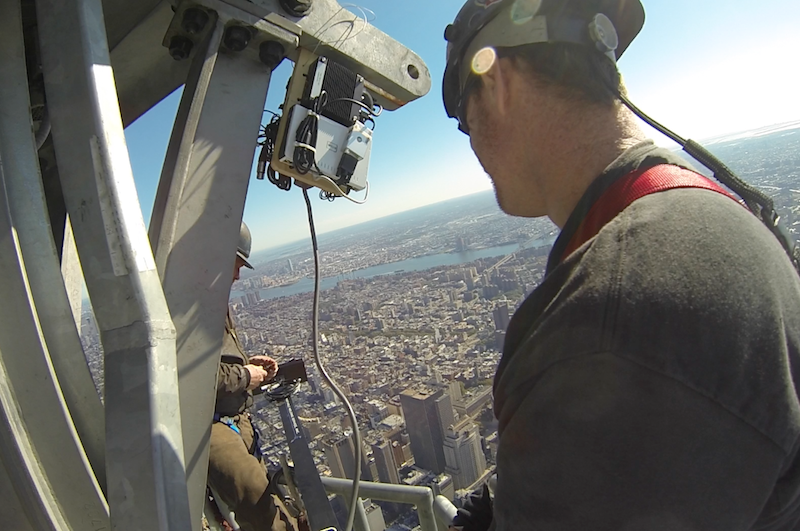
2) MCU: check. It’s now time to mount the EPIC Pro and camera to the jib. Jonathan and I very carefully remove the EPIC Pro and camera from the pack and tighten it onto the jib. Letting something this big slip from this high up is not something you want on your conscience. Safety means everything.
Once the Pro is mounted, we attach the power supply and USB cables to the Pro and Camera. Lastly, we clip in the safety cables, just in case anything fails.
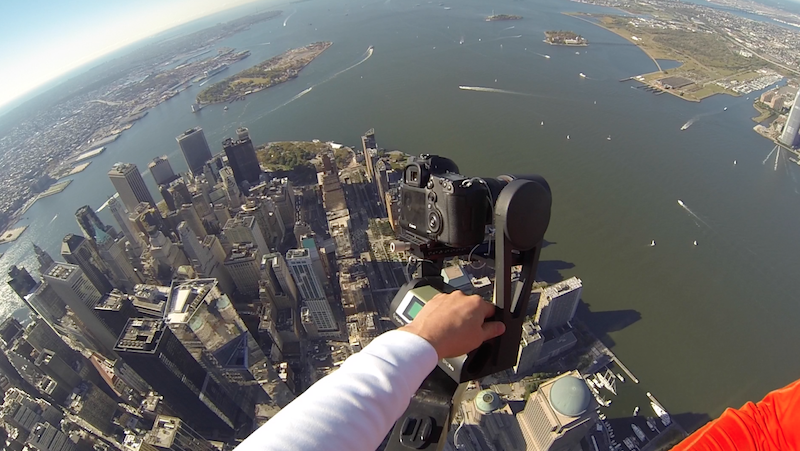
3) With the Pro and camera ready to go, we turn the job over to the ironworkers. These guys are amazing! They fearlessly hoist this awkward, unbalanced jib and Pro over their heads and into position.
As they slide the rear blade of the jib into the beacon’s hoist joint, I hear one of them say, “You guys are amazing! You thought of everything!” That I can only attribute to the amazing attention to detail of our Mechanical Engineer Michael Long.
Once the jib is secured in place with a bolt, we attach threaded steel rods for levers to hoist the Pro into position. In order to keep the Pro in position and level, Michael designed a tapered hole in the blade that would be used with a series of clocking pins. Each clocking pin was a different size so that we could precisely adjust the height of the Pro and ensure it is level. We have 8 clocking pins with us and it takes us 6 tries to find the right size to get us as close to level a possible. Did I mention Michael’s attention to detail?
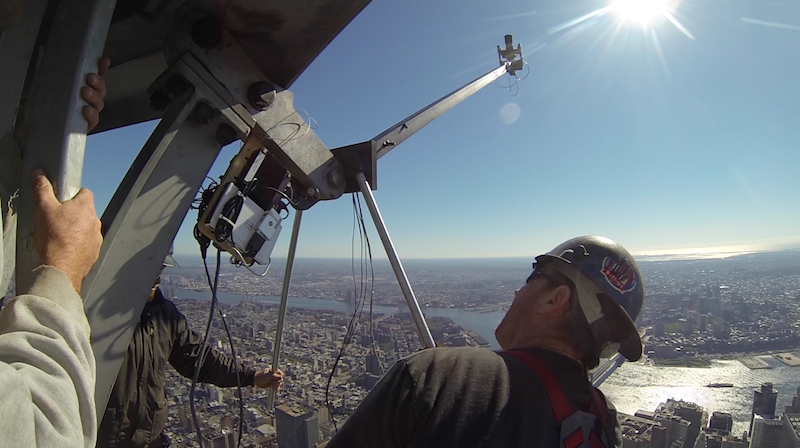
4) Now that everything is in place, I can finally assume my spot inside the beacon where I will settle in with my laptop, login to the remote CPU and run the show.
All right, back to your regularly scheduled programming.
As I take control of the Pro and camera, it becomes clear that we are encountering our first hiccup: the Pro is set to invert pan mode. This also means that the controls are reversed. Not a good start. Back down with the jib.
Remember me telling you how amazing and fearless these ironworkers were? Well, here’s an example: since fixing the invert pan is really pretty simple, Jim, one of the ironworkers, climbs down to the platform below and up one of the other ladders near the Pro to navigate the menu for us and put the Pro back into the correct shooting mode.
Now that we’ve solved that problem, they hoist the Pro back up into position, lock it into place and I take back over. My plan from the beginning is to shoot in columns, starting South so that when I reach the East where the Sun is it will be a little higher in the sky and reduce the longer shadows on the city. Time to get to work.

It’s amazing to watch all of these images come in; one by one, column by column, until every last one is accounted for. The nice thing about robotic pano heads and Capture Studio is that you can actually get a little downtime while the image is composed. It allows me to take in the view and try and fathom what I am a part of. To take in a city so rich in history from a vantage point that less than 20 people have been to.
With the top portion of the pano now complete, we once again lower the jib. This time we remove it from the hoist joint so we can remove the EPIC Pro, flip it to the underside of the jib and reshoot the bottom portion of the pano. This is an important part of the process as it allows us to remove the jib from the final image.
Jonathan and the ironworkers, have everything flipped and ready to go in a matter of a few minutes. Once again, it’s time for me to log in and take over. We reconnect the ethernet cable to the laptop, log back in to the remote CPU, start up Capture Studio, and nothing… no response from the camera or the EPIC Pro.
Fix one: I kindly ask the ironworkers to unplug and replug the USB cables. Still nothing.
Fix two, rinse and repeat: “One more time guys!” I shouted. Again, nothing!
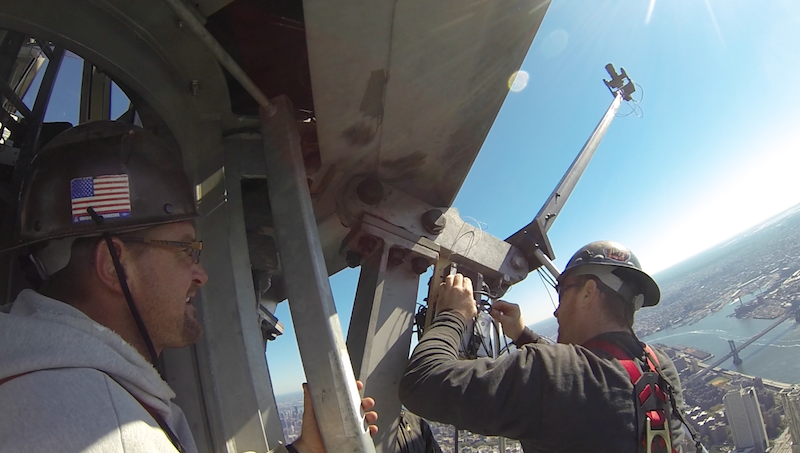
This is about the time I start to get a little concerned. The good news is there aren’t too many things that could be the problem and I have logged more hours on this software then anyone else. I’m determined to find the problem and fix it. We didn’t come this far to not finish.
After a few minutes of thinking, I have them lower the jib back down. It has to be an issue with power to the camera and EPIC Pro. Jim once again climbs down one ladder and back up the other to reset the power on both devices.
Fix three administered, fingers crossed: I go back to my laptop, login, startup Capture Studio… bingo, we’re back in business! All that’s left to shoot now is the bottom portion of the image. This should be a piece of cake. Returning to the South starting point so we don’t have alignment problems, I start the final round of images. Mild heart attack taken care of, I can once again sit back and just enjoy this.
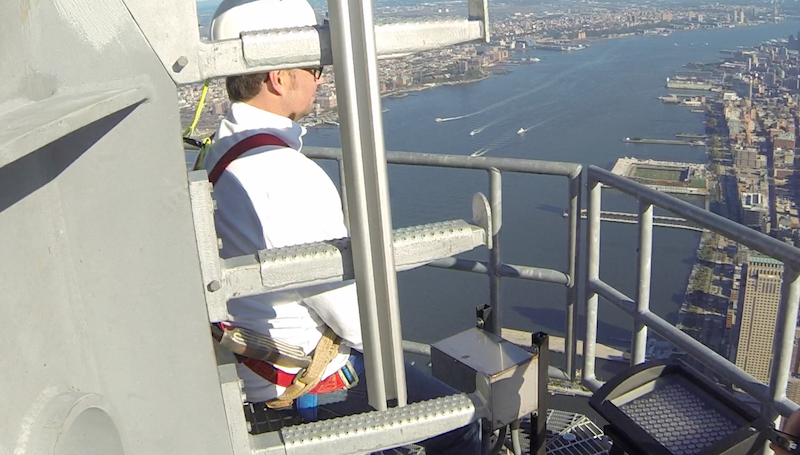
Image by image, the pano assembles magnificently until all that’s left is the Spire. The Spire is done in a matter of minutes, and we make one final check on the images — if there is anything else we want, we need it now. Further inspection leads us to the conclusion that we have done the best we can, and it’s now time for us to begin the descent.
I’m the first one to the bottom, greeted a few minutes later by Jonathan. I’m not sure either of us fully comprehended what our team has just accomplished. One thing is for sure through, we all feel like rock stars. As we load all the gear back into the elevator, I feel a twinge of sadness: moments like this are rare, and they often pass so quickly. It’s hard not to feel some form of loss.
Seven minutes back down to the bottom and we step out back on the ground. We load all the gear back to the construction trailer and share some stories with the men we just created a piece of history with. There is a great deal of work still left to be done in order to make the image ready for the world – but tonight, we celebrate.
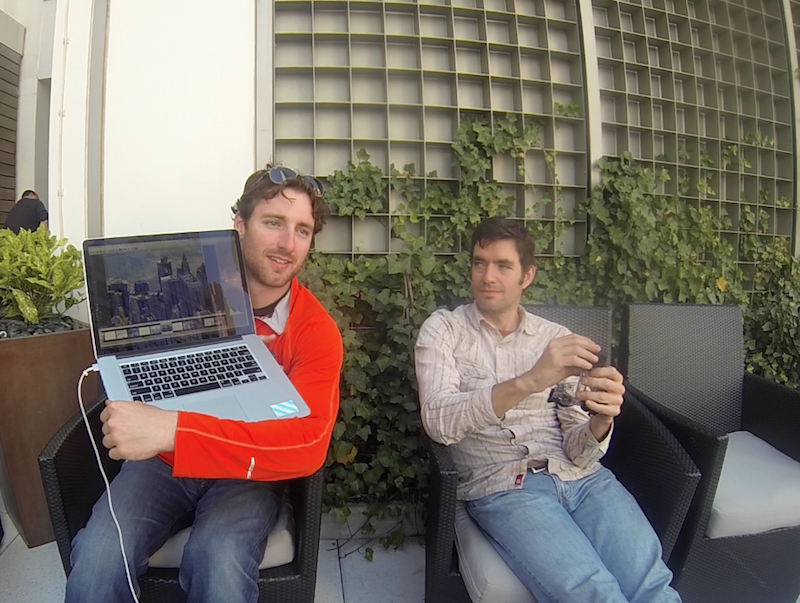
Last Days in New York
I didn’t move much the next day. My hands were raw from the ladder rungs, my knees were bruised from smacking the same, and overall exhaustion from the last two months had left me ready to tap out. It wasn’t until about 2pm that I mustered enough energy to take a shower and walk across the street for a burger and a beer. Well, maybe two beers.
That evening, after a magnificent dinner from the rooftop restaurant of the hotel and some Manhattan skyline pano shooting, I was joined by Jonathan.
![]()
He and I spent the next few hours pulling images and GoPro footage off the cards and saving them to multiple hard drives. One would stay with him and the other would go back with me. I would be responsible for stitching the images together and creating the final image.
We passed the hours sipping bourbon, laughing at each other’s stories and marveling at how everything had lined up perfectly for us to capture this image. We even managed to stitch together a low-res version that we would share with the team at TIME on Monday morning. Not a bad evening if I do say so myself.
Monday came and went pretty quickly. I spent the morning at TIME with Jonathan where I was invited into their photo meeting to share our initial image and some GoPro footage. Their reactions were, thankfully, amazing.
A Post-Processing Nightmare
On Tuesday, I hopped on a plane back to Portland where I would get to work on stitching and editing the image.
Nothing could have prepared me for what I was about to take on and attempt to accomplish. It was evident from the beginning that this image was going to need serious help. The initial stitch yielded fair results in most of the image, but the beacon and spire were a complete mess and the horizon needed help.
After banging my head against a wall, I decided to reach out to good friend and fellow panographer Gavin Farrell. He knew I was working on some huge project and was dying to see what we had done. Gavin also happens to be highly skilled when it comes to stitching difficult images. This image may be one of the more challenging he’s faced.
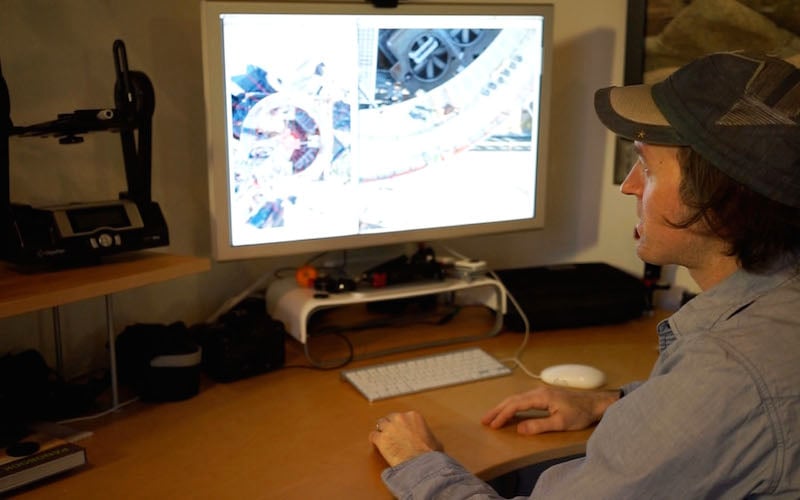
Gavin and I spent some time working through the issues in the image. I handled the more remedial tasks like the horizon and control points while Gavin took on the more challenging aspects of the image. But even our combined powers were not enough.
After a week or two, we threw in the towel and decided to bring in the big guns to fix the perspective change that had resulted from flipping the EPIC Pro. Luckily Gavin just happened to have an in with the perfect person: a Photoshop master and wonderful woman… his wife Meghan Farrell.
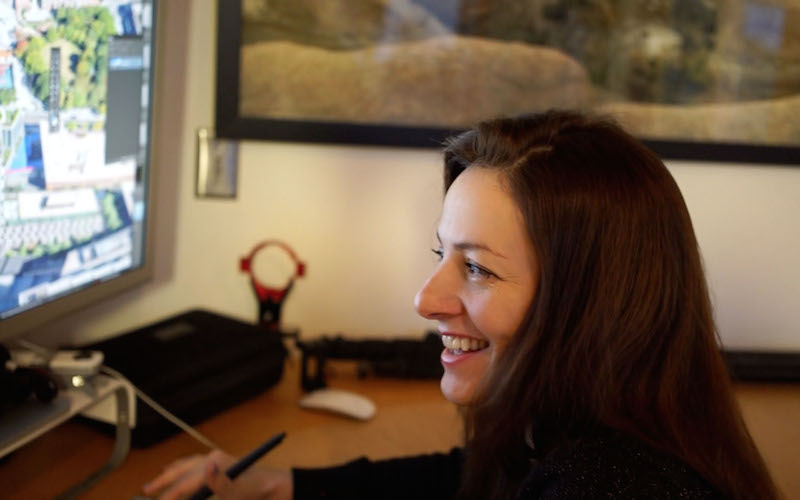
Finally, just before Thanksgiving, Gavin and Meghan finished up with the image and handed it back to Jonathan and I.
Conclusion
Gigapixel images are by nature interactive. The detail you can see makes them far different than your average photo, and effectively sharing this was a top priority. But this image was part of something larger.
It was part of a project surrounding the healing of New York, the reclaiming of the sky where the original towers stood, and the 10,000 workers that made this possible.
There was already talk surrounding a potential cover for this photo back in November, but things change daily in the news world and while Jonathan and I hoped it would come true, he was always clear that something could always take priority.
It wasn’t until the end of January that I was told there was a concrete plan for the cover. January 31st, I received a proposed final cover that would wrap from the back, to the front, to a fold out — a first in TIME’s 91-year history and privilege for both Jonathan and I.
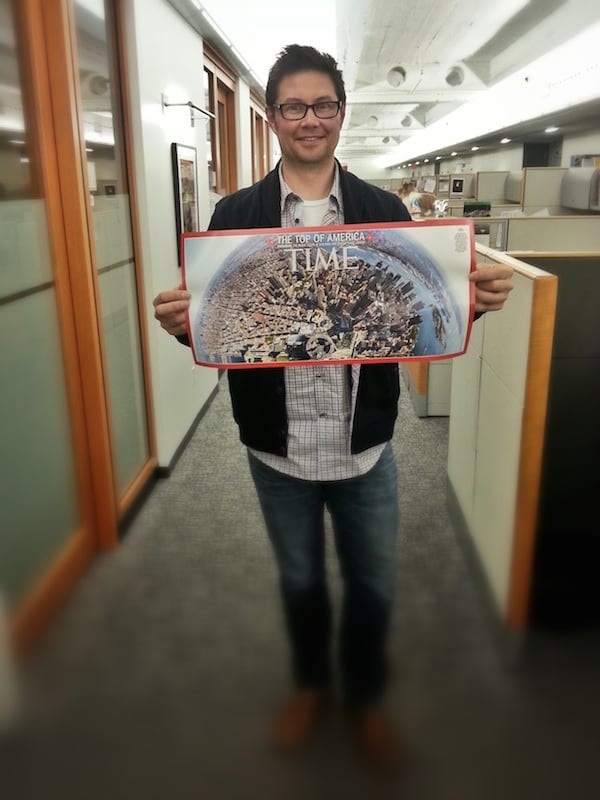
I continued to juggle my flight schedule until we were finally confirmed for March 6th, 2014 as a launch of the image, as it was important for me to be back in New York when this image went live.
I could tell you that it was to work closer with TIME to make sure that this image would be able to handle the traffic we anticipated it would have… I could say that is was to make sure that the transition from site-to-site for purchasing prints was flawless, or even to help finalize and manage the minor tweaks that the viewer needed. All of these would be true. The deeper truth, however, is that I wanted to be with my friend and colleague Jonathan, who had had enough faith in my abilities to bring me along on this journey.
I remember Wednesday afternoon March 5th, 2014 very clearly. Jonathan and I had been working all day to render our different views of the image for several publications while at the same time managing our other day-to-day tasks. It was about 3:30pm when we finally stepped out to get something to eat.
We walked outside the TIME & LIFE Building, and a moment later, the email came. They had just shipped our One World Trade Center image as the cover image for the March 17th, 2014 issue of TIME magazine.
I’m not sure I can describe the feeling that overcame me at that moment, but I can tell you that it was the perfect way to receive the news: Just Jonathan and I, away from the chaos of the office, with a moment to ourselves, to reflect on what we had accomplished.
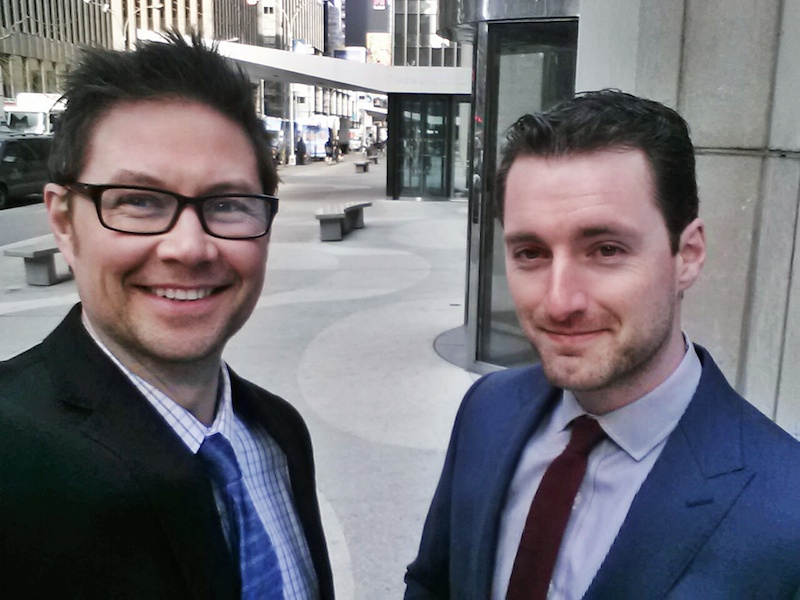
Epilogue — The Deeper Meaning
The terrorist attacks on September 11th, 2001 were an atrocity. It tore a hole in all of our hearts, and each American was affected differently, but I’ve come to realize that the closer you were to ground zero, the deeper the wound. No one felt the pain more than the people of New York.
This project gave me more than I could ever hope to give the people of New York with this image. It has given me a deep connection with a magnificent city that is full of compassion, grit, pride and love. This will forever live in my memory as one of the greatest moments in my life. For that I am grateful.
About the author: Mike Franz is a photographer, gigapixel photography expert and educator, and the Director of Products and Training for Gigapan. He has a passion for night photography and long exposures, and is one of a handful of people to have enjoyed the view from the top of the One World Trade Center. You can find more of his photography on his website or by following him on Twitter or Instagram.
P.S. If you want to learn more about this amazing experience and how the panorama came together, Mike has agreed to answer some questions for us. We haven’t decided how we’re going to publish his answers yet, but if you want to know anything at all about the photo — be it technical stuff, questions about the view or just general gigapixel information — drop your questions in the comments or tweet them to us with the hashtag #petapixelQ&A. We’ll compile them all and Mike will answer the most popular questions himself!